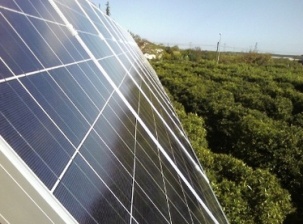Photovoltaic modules

Nowadays, modules are commonly made up of 36 cells in series, which allows them to be coupled with 12 DCV nominal accumulators. To produce the modules, the cells are connected and welded together by means of terminals on front and back contacts (in sequence N-P-N-P-N...) so as to form strings.
This produces a sandwich, whose centre is the plane of the cell surrounded by, starting from the outermost layer, a sheet of fibre glass equipped with excellent transmittance and high mechanical resistance followed by a sheet of EVA (ethylene vinyl acetate) sealant which permits the dielectric isolation of the adjacent layer of cells, a second sheet of EVA and a further sheet of glass or an isolating coating in Tedlar.
The sandwich is then heated in the oven at approximately 100°C, a temperature at which the components become sealed to one other. The semi-transparent EVA becomes transparent and the residual air contained within, which could provoke corrosion, due to the presence of watery vapour, is eliminated.
Finally, the sandwich is locked into an extruded aluminium frame that is anodised (to resist corrosion) and the junction box is prepared.
SOME DEFINITIONS
STC (Standard Test Conditions)
G incident = 1.000 W/m²
T modules = 25°C
Spectrum = 1,5 AM
Wind = 0 m/s
NOCT (Nominal Operating Cell Temperature)
G incident = 800 W/m²
T air = 20°C
Wind = 1 m/s
NOCT Typical = 45 - 50°C
Example:
| Type of module | Pnom. [Wp] | Impp [A] | Icc [A] | Vmpp [V] | Vo [V] |
| Sharp ND-L3E6E | 123 | 7,16 | 8,12 | 17,2 | 21,3 |
| Sharp NE-L5E2E | 125 | 4,80 | 5,46 | 26,0 | 32,3 |
| Sharp NE-Q5E2E | 165 | 4,77 | 4,46 | 34,6 | 43,1 |
| Sharp NT-R5E2E | 175 | 4,95 | 5,55 | 35,4 | 44,4 |
Grey Energy
This is the quantity of energy necessary for the entire production cycle of a module (extraction of raw materials, transport, processing)
Energy payback time
This is the time the module needs to produce a quantity of energy equivalent to its own grey energy.
Energy return on investment
This is the relationship between the module's life expectancy and its energy payback time (or between Etot and Egrey).
| Unit | Mono silicon | Multi silicon | Amorphous silicon | |
| Grey energy | kWh/Wp | 5-8 | 3.5-7 | 2.5-4 |
| Energy payback time | years | 3.9-6.6 | 2.9-5.8 | 2.1-3.3 |
| Energy return on investment | - | 3.7-6.4 | 4.3-8.6 | 7.5-126 |
Hypothesis: specific annual production = 1,200 [kWh/kWp]; life expectancy 25 years; without taking into account the type of application.
In its lifetime a photovoltaic module produces between 4 and 10 times more energy than the amount required to make it.
Only those energy systems which use renewable sources have an energy return investment higher than 1.

